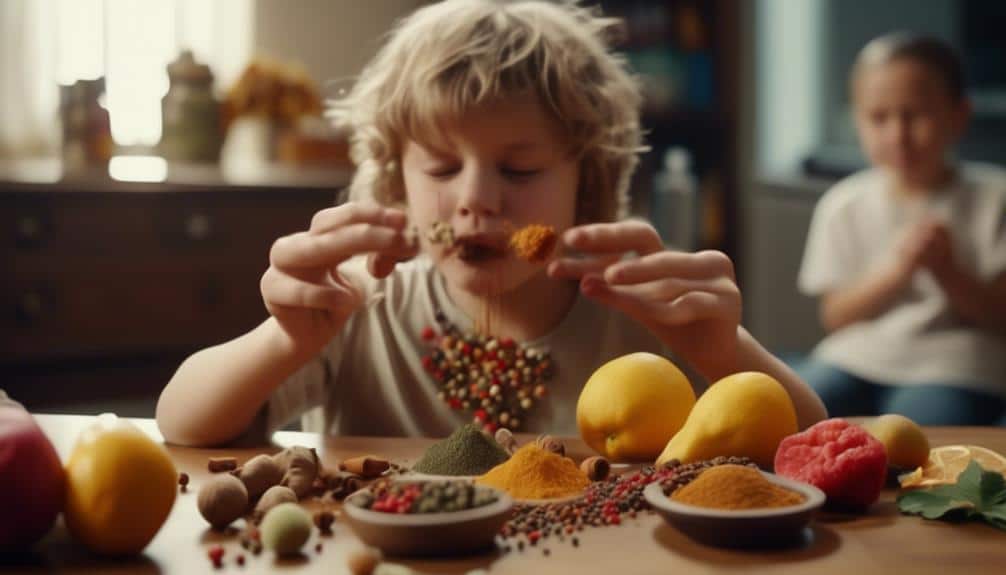Imagine your senses are like a symphony – when each instrument plays in harmony, the experience is delightful, but one discordant note can change the entire sensory landscape. If you’re navigating the complexities of Sensory Processing Disorder, you’re well aware that finding suitable therapeutic activities can be as nuanced as composing a masterpiece. It’s crucial to understand that therapeutic activities for sensory processing and sensory needs aren’t just games; they’re vital tools that can help bridge the gap between discomfort and engagement for you or your child.
You’re likely seeking strategies to provide that much-needed sensory input or create a sense of balance and regulation in an overwhelming world. Stay tuned as we explore a range of therapeutic interventions that may alleviate sensory challenges and enrich daily experiences, offering a glimpse into the potential for harmony in the sensory symphony of life.
Key Takeaways
- Sensory integration techniques, such as sensory gyms and obstacle courses, can provide comforting environments and promote positive growth for children with sensory processing issues.
- DIY sensory bins with textured materials, such as rice, beans, or beads, can enhance body awareness and fine motor skills for children with SPD.
- Vestibular strengthening exercises, like log roll yoga and sensory swings, can improve balance, coordination, and spatial awareness.
- Using auditory processing strategies, visual aids, and schedules can help individuals with SPD better comprehend and retain information while improving visual coordination and perception.
Sensory Integration Techniques
To effectively support children with sensory processing disorder, sensory integration techniques, such as using a sensory bin or navigating an obstacle course, provide essential tactile, proprioceptive, and vestibular feedback that can enhance their comfort and development. Occupational Therapy practitioners use these methods to address sensory processing issues in a playful yet purposeful manner.
Imagine a sensory gym tailored to offer a comforting experience for your child. Equipped with swings and ball pits, it’s a place where your child can explore and learn in a way that’s best suited for them. Incorporating heavy work activities can be remarkably calming, delivering proprioceptive input that helps regulate their sensory system. Pushing, pulling, and lifting promote a tranquil environment and improve their body awareness and muscle tone.
Craft a sensory bin filled with rice, beans, or sand to allow tactile exploration, or set up an obstacle course that challenges their motor planning and coordination. These activities are integral to sensory integration techniques. They are designed to playfully stimulate the vestibular system, fostering balance and spatial orientation. By engaging in these therapeutic activities, you’re helping to pave a path for positive growth and sensory comfort for your child.
Proprioceptive Input Activities
Have you ever wondered how simple pushing, pulling, and climbing can be therapeutic for children with sensory processing disorder? These actions are part of proprioceptive input activities, which involve heavy work that provides deep pressure and resistance to muscles and joints. They are essential for helping children with SPD to integrate sensory information effectively.
Proprioceptive input activities can be seamlessly incorporated into a child’s daily routine. They can include fun and engaging exercises, such as pushing a trolley, sweeping, or jumping on a trampoline. These activities offer the necessary sensory input, promote physical activity, and enhance focus before tasks requiring attention.
Here’s a table outlining some practical proprioceptive input activities:
| Activity | Benefit | Example Usage |
|---|---|---|
| Pushing/Pulling | Strengthens muscles and provides input. | Pushing a heavy shopping cart. |
| Climbing | Improves coordination and awareness. | Climbing on playground gear. |
| Weighted Objects | Offers passive deep pressure input. | Using a weighted vest or lap pad. |
| Oral Exercises | Provides feedback to jaw muscles. | Chewing gum or using chew toys. |
Tactile Sensory Play

As you explore tactile sensory play, you’ll find that activities like finger painting or using shaving cream can be both fun and therapeutic. Creating DIY sensory bins with various textured materials encourages hands-on discovery and learning. These engaging experiences soothe and enhance body awareness and fine motor skills.
Exploring Textured Materials
Delving into the world of textured materials, you’ll find that sensory bins offer a dynamic and engaging way for children with Sensory Processing Disorder to encounter a variety of tactile sensations while also enhancing vital developmental skills. Whether you’re addressing tactile defensiveness or encouraging seeking tactile experiences, sensory bins are a versatile tool.
Here are some ideas to get started:
- Fill a bin with rice, beans, or beads and hide small toys for a treasure hunt.
- Create homemade playdough for kneading, rolling, and shaping.
- Incorporate items like sponges, feathers, and fabrics with different textures.
DIY Sensory Bins
Creating your sensory bins at home can be a fun and effective way to support your child’s tactile exploration and sensory integration. By using simple household items, you’ll provide rich sensory input that can help your child process sensory information in a safe and controlled environment. Plus, it’s a beautiful way to bond as you both discover the joy of creating together.
Here’s a table with ideas for objects to create your kids’ sensory bins:
| Material | Benefit | Emotion |
|---|---|---|
| Cotton Balls | Soft texture | Calmness |
| Beans | Fine motor skills | Curiosity |
| Buttons | Visual perception | Fascination |
| Homemade Playdough | Creativity | Joy |
| Rice | Auditory input | Relaxation |
Vestibular Strengthening Exercises
Vestibular strengthening exercises can be a game-changer when you’re looking to bolster your balance and coordination. Movement like swing therapy supports sensory integration and brings joy and freedom. Incorporating these exercises into your routine can significantly enhance your body’s response to movement and gravity, offering a solid foundation for daily activities.
Balance Coordination Drills
To enhance your child’s balance and coordination, consider incorporating balance coordination drills, such as Log Roll Yoga and sensory swings, which target the vestibular system and are pivotal for sensory integration. These activities stimulate the vestibular receptors in the inner ear, promoting sensory processing and bilateral coordination through dynamic movement activities.
- Log Roll Yoga: Strengthen your child’s muscle tone and coordination by encouraging them to perform rolling movements across the floor, simulating the sensation of tumbling.
- Sensory Swings: Use swings to provide gentle, rhythmic motion that enhances balance and spatial awareness.
- Daily Dance Parties: Engage in joyful movement with music to help your child develop coordination and rhythm while having fun.
Swing Therapy Benefits
Incorporating swing therapy into your child’s routine can significantly bolster their vestibular system, improving balance and coordination with each gentle sway. This form of sensory integration, essential in Sensory Processing Disorder management, offers a harmonious blend of fun and therapeutic benefits. As your child engages with the motions, they’re not just playing—they’re undergoing vestibular strengthening exercises vital for their development.
Swing therapy benefits extend to enhancing muscle tone, postural control, and bilateral coordination. It’s a cornerstone of Occupational Therapy that taps into the body’s need for movement and gravity. Additionally, pairing swing therapy with activities like log roll yoga can create a robust regimen for balancing and strengthening their nervous system, all within the comforting embrace of your home.
Auditory Processing Strategies

Understanding how to navigate auditory processing challenges can significantly enhance daily functioning for individuals with Sensory Processing Disorder. Responding to sensory stimuli and noises can be overwhelming, but using the right auditory processing strategies can mitigate discomfort and improve overall well-being.
Here are a few practical approaches that Occupational Therapists often recommend:
- *Use noise-canceling headphones* to minimize overstimulation in noisy environments.
- *Break down auditory information* into smaller parts to make it more digestible.
- *Employ visual aids and schedules* to reinforce auditory instructions and reminders.
Using noise-canceling headphones can create a quieter space for yourself, allowing better focus and reducing stress caused by unexpected or loud noises. When receiving complex information, it’s helpful to have it broken into smaller, manageable chunks. This can prevent feeling overloaded and ensure better comprehension and retention.
In addition, supplementing verbal communication with visual supports can be incredibly beneficial. Visual aids or written instructions can be a reliable reference when auditory processing becomes challenging. Visual schedules or planners are also excellent tools to complement auditory cues, keeping you organized and prepared without relying solely on verbal reminders.
Visual Coordination Practices
While sensory bins filled with varied textures can sharpen your visual perception, they also enhance fine motor skills as you explore and play. These bins are not just fun but a cornerstone in developing visual and tactile skills for children with Sensory Processing Disorder (SPD). Occupational Therapy often employs playful methods to engage children in therapeutic activities that meet their unique needs.
Additionally, creating with homemade playdough can be a multi-sensory feast. It encourages children to follow directions and molds their visual coordination as they pinch, roll, and shape. This simple activity is not only therapeutic but also fosters creativity and imagination.
Introducing log roll yoga into your routine can significantly benefit muscle tone, postural control, and bilateral coordination. Calming and organizing practice can positively impact your child’s vestibular system, which is critical for sensory integration.
Engage in games like hot potato and straw races to inject fun while honing visual perception and coordination. These games promote attention and social interaction, which are valuable for children with SPD.
Oral-Motor Skill Development

Integrating fun and practical activities can significantly enhance your child’s oral-motor skills. Chewable jewelry, often called ‘chewelry,’ offers dual benefits by providing a safe option for chewing while aiding in sensory regulation. Additionally, using straws for drinking and engaging in whistle games can improve these skills enjoyably and interactively.
Chewable Jewelry Benefits
Chewable jewelry offers a practical solution for children with sensory processing disorder, enhancing oral-motor skills and providing necessary sensory feedback in a discreet and socially acceptable manner. As you explore options for sensory integration, consider these chewable jewelry benefits:
- Promotes Self-Regulation: Aids in managing sensory needs, offering a tool for self-calming during overwhelming situations.
- Improves Focus: Satisfying the oral sensory input can help children with sensory processing concentrate better on tasks.
- Portable Convenience: Easily incorporated into a sensory diet, it’s a handy option for occupational Therapy on the go, ensuring consistent sensory input throughout the day.
Straw Drinking Techniques
Using chewable jewelry’s benefits for sensory regulation, straw drinking techniques offer another avenue to enhance oral-motor skills and coordination. You’re actively engaging in sensory integration by practicing various straw exercises, such as blowing bubbles or sipping thicker liquids. These activities stimulate the vestibular system and proprioception, creating a more balanced sensory experience.
Remember always to prioritize proper oral hygiene and safety while utilizing these techniques. It’s crucial to consult with therapists to tailor the practices to individual needs, ensuring that the straw drinking exercises serve as practical heavy work activities for the mouth, strengthening oral motor skills in a way that’s not only beneficial but also enjoyable. Your guidance can make a significant difference in someone’s sensory journey.
Whistle Games Engagement
Engage your child in whistle games to foster the development of oral-motor skills and enhance sensory processing playfully and effectively. These activities support motor skills and contribute to your child’s vestibular and body awareness, which is crucial for those with sensory processing disorder. Here’s how you can incorporate whistle games into your child’s routine:
- Start with simple blow-and-chase games, using the whistle to propel a cotton ball across a table.
- Introduce different whistle sounds to practice modulation and control.
- Encourage whistling along to favorite tunes to make it a joyful, therapeutic activity.
Olfactory and Gustatory Exercises

Exploring a variety of scents can enhance your child’s olfactory skills, allowing them to identify and connect different aromas with their experiences. Sensory integration is vital in Occupational Therapy, especially for a Sensory Smart Child with Sensory Processing Disorder. By introducing distinctive scents and helping your child describe each, you’re broadening their sensory repertoire and aiding their cognitive development.
Incorporate taste-testing activities that invite your child to explore various flavors and textures. This stimulates their gustatory senses and can be a fun and educational experience. Use scented markers or play dough to combine creativity with sensory exploration, making the experience enjoyable and memorable.
Involving your child in meal preparation is another practical approach. It offers a hands-on way to experience different tastes, textures, and temperatures, fostering independence and life skills.
Deep Pressure Applications
When your child feels overwhelmed, deep-pressure applications like weighted blankets or lap pads can offer a comforting embrace, helping them regain emotional balance. These tools are more than just cozy; they’re an integral part of sensory integration techniques used in occupational Therapy. They provide passive proprioceptive input that can be incredibly soothing for children with sensory processing disorder.
Here’s how you can incorporate deep-pressure applications into your child’s routine:
- Weighted Blankets: These can be used during rest time or while your child is seated, adding a gentle, steady pressure that mimics a hug.
- Snug Kiddie Armchairs and Beanbags: Perfect for creating a comforting space, they offer the snugness that can help your child feel secure.
- Pillow Packing: Placing pillows on your child while lying on a mat delivers deep pressure stimulation that promotes calmness and focus.
Interactive Metronome Therapy

While deep pressure applications help calm the senses, Interactive Metronome Therapy offers a dynamic approach to enhancing coordination and timing in individuals with sensory processing challenges. This computer-based program is a valuable tool in Occupational Therapy, designed to improve the synchronization of movements to a specific beat. As you seek to help your child navigate the complexities of sensory processing disorder, consider how this Therapy could support their development.
Interactive Metronome Therapy focuses on honing attention, motor planning, and processing speed, which are often difficult for children with sensory integration issues. By engaging in exercises that match rhythmic beats with physical actions, your child can develop better motor control, sharpen their attention, and fine-tune their coordination and rhythm. This can profoundly impact their daily activities and overall quality of life.
What’s more, the Therapy is adaptable, allowing you to target specific areas where your child may struggle, such as timing or attention deficits. It’s a hands-on, engaging way to bolster their needed functional skills. With consistent practice, children can make significant strides in managing sensory processing disorder, all through the innovative use of Interactive Metronome Therapy.
Frequently Asked Questions
What Is the Best Therapy for Sensory Processing Disorder?
The best Therapy for sensory processing disorder often includes personalized occupational Therapy tailored to your child’s specific needs, incorporating sensory-friendly activities and strategies for daily life.
What Are the Best Therapeutic Activities for Sensory Processing?
You’ll find sensory bins, homemade playdough, and log roll yoga effective for sensory avoiders. They offer tactile stimulation, encourage following directions, and improve coordination—all while being fun and supporting their needs.
What Are Coping Strategies for Sensory Processing Disorder?
Coping with sensory overload isn’t easy, but you’re not alone. Implementing a sensory diet and creating a calm environment are vital strategies that can offer much-needed relief and support daily functioning.
How Do You Calm a Child With Spd?
To calm a child, create a serene space with soft pillows and a bean bag for retreat. Engage them in activities like pushing a cart or using weighted blankets for comforting pressure.
Conclusion
Sensory processing issues can cause many challenges for children. Sensory integration therapy can help children with sensory challenges to develop better control of their body, awareness of their body senses, and improved cognitive skills. Sensory diets are an excellent activity to help with this process.
Sensory diets include various sensory activities that can help children with sensory processing issues. These can consist of movement activities, such as horseback riding, or sensory input activities, such as heavy work or deep pressure input. Tactile activities, such as playing with beans or cotton balls, can help with tactile processing and tactile experiences.
Children with sensory issues may benefit from sensory-seeking activities like playing in ball pools or using therapy balls. They may also benefit from activities that provide vestibular input, such as swinging or using a laundry basket as a ride-on toy.
For children with autism spectrum disorder or attention deficit hyperactivity disorder, therapy balls or fanny packs filled with heavy balls can provide proprioceptive input. Activities such as using a medicine ball or playing catch can also be helpful.
Sensory integration exercises, such as voice volume control or a pretend volume control button, can help with oral motor control and speech development. Sensory regulation activities, such as using bear hugs or chewy foods, can help children reach their optimal level of arousal.
Parents, teachers, and occupational therapists can use these resources for children regularly to help them progress through the phases of sensory development. By incorporating fun activities such as playing with lava lamps, using paper plates of different colors, or playing with a ball, children can improve their perceptual and visual skills while having fun.


Recent Comments